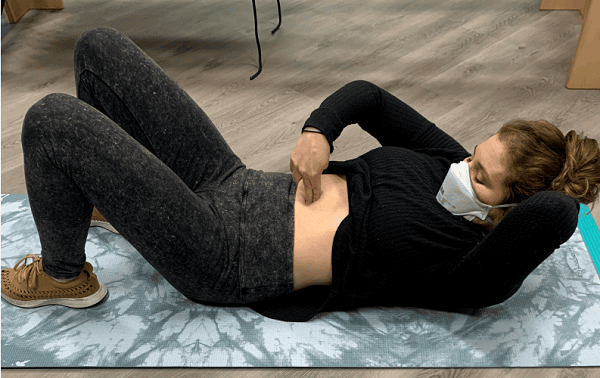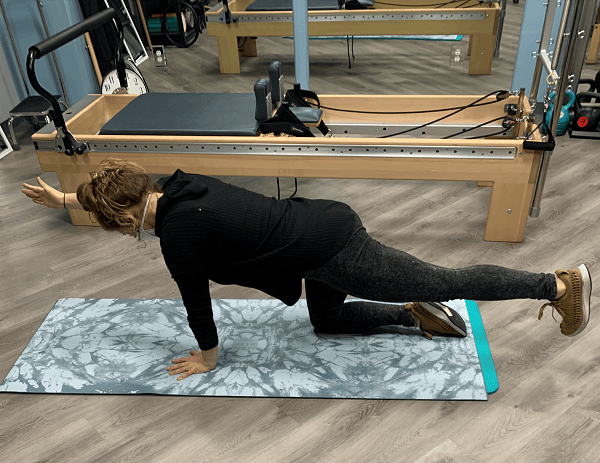What is DRA?
Diastasis rectus abdominis (DRA, sometimes referred to as Diastasis Recti) is a distortion or thinning of the linea alba which is the midline of the abdomen that connects left and right rectus abdominis muscles together.
Although DRA can be found in both genders, it is more commonly found in females, and more common during pregnancy (66-100% of women have DRA during their third trimester) and can persist through their postpartum periods. About 33% of women continue to have a DRA a year postpartum. It can look like a gap in the midline, “doming” in the midline, or it can even appear as a “pooch,” in the lower abdomen.
Why Do We Care?
The abdominal muscles and linea alba assist in trunk movement, posture, lumbopelvic stability, breathing, and abdominal organ support. As you can imagine, it can affect those functions when a DRA is present. As movement specialists, we want to make sure you are engaging the muscles and tensing up the fascia of the linea alba appropriately to help prevent low back pain, pelvic girdle pain, and activity-related injuries.
How to Assess Diastasis Rectus Abdominis?
The best way to measure DRA is through ultrasound.
However, clinically, we use the finger width examination to measure interrectus distance (distance between the left and right rectus abdominis muscles):
- At rest: Lie down flat on your back, place two fingers at midline at the top of the abdomen (right below your breast bone) and feel for bulging, sinking in, or other puckering, etc. and assess how the tissue may change as you move your finger down all the way to your pubic bone
- Then place your two fingers about 2 inches above the belly button and sink your fingers in a little bit. Perform a gentle neck curl-up (preferably shoulders off the floor). What happens to your fingers? Do they come up out of the abdomen (doming), do they sink in deeper, or can you feel tension build up in the tissue? Now bring your two fingers into your belly button and perform the same thing. Now bring your two fingers about 2 inches below the belly button and perform the same thing and compare how it feels/reacts at the different locations.
Not only are we checking for width and depth of the midline as you curl your neck up, but you are also checking for doming. Ideally, we like to feel the fascia tense as it loads without any distortion. If you are experiencing a gap (i.e. fingers are sinking in), a two-finger width is considered a DRA. If there is doming (fingers popping up and out as you lift your head), it is a sign that there is poor loading of the linea alba and is considered dysfunctional. We try to train to activate the transverse abdominis muscle prior to the movement, and then the rectus abdominis muscles activate to complete the sit-up activity; this way, no doming or sinking occurs.


Treatment for Diastasis Rectus Abdominis:
The goal of treatment is to create tension in the linea alba to help with the functions of abdominal support and lumbopelvic stability.
This may help decrease the DRA interrectus distance, but not always. The most important thing is that you know how to implement strategies to decrease the distortion of the linea alba to prevent visceral and musculoskeletal injuries, especially during exercise and sport activities. In our offices, we like to focus on posture, breathing mechanics with activities, connective tissue of the abdominal wall, and targeted muscle strengthening (especially transverse abdominis and multifidus muscles!) to help treat DRA.
- Breath mechanics: It’s helpful to exhale before and as you perform an activity, such as getting out of bed, lifting or bending over; this helps engage your transverse abdominis (see #3)
- Abdominal wall connective tissue/trigger points: sometimes there are restrictions in the abdominal wall that can hinder our ability to heal from DRA. Pelvic floor physical therapists are trained to help improve the integrity of the skin/connective tissue. But if you don’t have access to a pelvic floor physical therapist, start massaging your abdomen and see how it feels
- Transverse abdominis (“TA”) strengthening: The TA is the deepest abdominal muscle and shares fibers with the aponeurosis of the rectus abdominis and linea alba. So when we engage the TA prior to a certain activity, it helps bring the rectus abdominis muscles together without doming and provides stability during activities or exercises. Through this connection, the transverse abdominis has been clinically shown to be beneficial in helping improve the tension of the linea alba, and thus improve function!
- Multifidus strengthening: Strengthening the multifidus (a deep lumbar muscle) also helps strengthen the transverse abdominis muscle. In fact, one study showed that those who had weaker multifidus strength, was associated with poor ability to engage the TA and is a common finding in those with low back pain (Hides et al, 2011)
In Conclusion…
Diastasis rectus abdominis may be common during pregnancy and postpartum periods, but being proactive about it, learning how to breathe with activity, how to engage these muscles now can help optimize the function and help you return to doing the things you love in a safe and pain-free manner. Any questions? Contact us for more info.
References:
Cardaillac C, Viellefosse S, Oppenheimer A et al. Diastasis of the rectus abdominis muscles in postpartum: Concordance of patient and clinician evaluations, prevalence, associated pelvic floor symptoms and quality of life. Eur. J. Obstet. Gynecol. 252 (2020) 228-232.
Hides J, Stanton W, Mendis MD, Sexton M. The relationship of transverse abdominis and lumbar multifidus clinical muscle tests in patients with chronic low back pain. Manual Therapy 16 (2011) 573-577.
Lee D, Hodges PW. Diastasis rectus abdominis – Should we open or close the gap? Musculoskeletal Science Practice. 2017;28:e16.
Lee D. & Hodges P. W. (2016) Behavior of the linea alba during a curl-up task in diastasis rectus abdominis: an observational study. Journal of Orthopedic and Sports Physical Therapy 46 (7), 580–589.
Sperstad et al. Diastasis rectus abdominis during pregnancy and 12 months after childbirth: prevalence, risk factors and report of lumbopelvic pain. Br J Sports Med 2016; 50(17):1092-6. doi:10.1136/bjsports-2016-096065.
More Articles in This Series
Safely Returning to Activity and Sport | Postpartum Recovery Series - Part 1

Restless Legs Syndrome & Physical Therapy | Postpartum Recovery Series - Part 3

Incontinence During Pregnancy & Postpartum | Postpartum Recovery Series - Part 4

How to Manage Urinary Incontinence After Childbirth | Postpartum Recovery Series - Part 5











